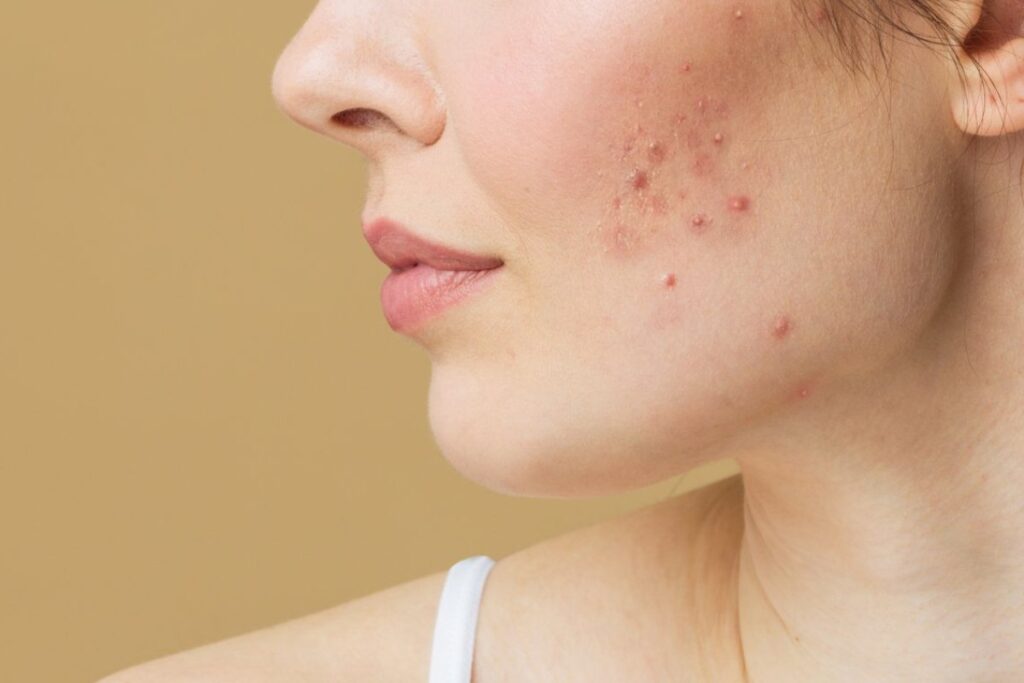You can lessen the redness and swelling of pimples by choosing certain skin care products, such as gentle cleansers and hypoallergenic moisturizers, among other methods.
Even a special 10-step skincare routine can lead to acne. If you suffer from red, irritated acne scars, there are ways to reduce the redness through skin care.
However, if you’ve landed on this page with a little time on your hands, there are also tips on how to hide imperfections until you can blush well.
How To Reduce Redness From Acne
The key to reducing acne redness is to apply anti-inflammatory products to your skin gently. That’s right – soft. This means don’t try to use scrubs or other irritating products to treat your acne. Instead, try a “keep it simple” approach.
If you apply too much oil remover, your skin may react oppositely: it may begin to produce excess oil, making your acne worse. The goal is to cleanse the skin and apply targeted products to reduce redness while the pimples heal.
Here are some tips for reducing redness:
- Cleansing: Cleanse your skin twice daily (morning and evening) with a gentle cleanser that is fragrance-free and non-comedogenic (will not clog pores).
- Niacinamide: Add a niacinamide product to your everyday routine. It is a water-soluble form of vitamin B3 that has been shown to reduce inflammation and redness associated with acne. You can usually use a serum or cream in form.
- Salicylic acid: Apply current salicylic acid to red, irritated areas. Trusted Source Salicylic Acid is an exfoliant that also has anti-inflammatory (anti-redness), antibacterial and antifungal properties when used in concentrations ranging from 0.5 to 5 per cent.
- Acne patches: Consider acne patches or patches. If the redness is limited to one (or two) areas, you can buy a rash patch designed to reduce the appearance of the rash. Most contain niacinamide, salicylic acid, vitamin C, or some grouping of ingredients designed to reduce the appearance of acne and speed up healing.
- Ice: Apply an ice pack containing a cloth or piece of ice to the red areas. Leave for 10 minutes or less.
- Hypoallergenic: Use a light, non-comedogenic moisturizer to keep your skin dry. Some of the keywords to look for when purchasing include “hypoallergenic” in the cream or gel formulation, which often contains moisture, such as hyaluronic acid.
Sometimes, you will need to see a specialist if your rashes are persistent, painful, and swollen. A dermatologist can evaluate your skin and prescribe professional treatments such as topical applications, chemical peels, or laser treatments.
Acne is also very similar to rosacea, a condition that causes redness of the skin. Because treatment for rosacea may differ from traditional acne treatment, if you’re unsure, it’s a good idea to see a dermatologist.
You can also apply a small amount of cortisone cream to the inflamed rash to reduce redness and swelling. This should be done carefully, as a spot treatment only, as topical steroids can cause acne, as well as other possible side effects such as thinning of the skin.
How To Use Makeup To Cover Redness of Pimple
Sometimes, even the best efforts to reduce redness don’t produce results quickly enough. In this case, you can use makeup to hide the redness. Here’s how to get started:
- Wash your hands systematically before touching your skin.
- Cleanse and moisturize your skin.
- Apply base makeup (if you are wearing it). It’s usually not full-coverage makeup (sometimes heavier makeup is a gift if you have a blemish). Instead, try a tinted moisturizer or lightweight foundation.
- Choose something that hides flaws. It would be best if you looked for a permanent cotton (thin) concealer. Some cosmetic companies offer green colour-changing concealers that can especially help with red pimples. If not, apply concealer as close to the skin as possible.
- Take a small, sparkling makeup brush and apply it around the pimple, blending it well into the surrounding skin.
- Fill the lid with powder (of course, or pressed – that’s fine).
- Sometimes, you may want to apply more than one level of privacy. You can apply the first layer of concealer, wait a few minutes, and then apply another layer.
- After use, clean your makeup brush with a mild cleanser or rubbing alcohol to cover imperfections.
To cover your pimples, you should use an oil-free, non-medicated product. Otherwise, you risk making things even worse.
How To Keep Acne Away
Regular skin care is helpful in reducing redness, as is maintaining an anti-acne regimen. A skincare routine to prevent acne should include the following:
- Cleanse your skin twice a day with a mild cleanser.
- I am using local anti-acne products. These may contain azelaic acid, benzoyl peroxide, or topical retinoids (such as adapalene). Each has different acne-fighting abilities, including antibacterial and exfoliating properties.
- According to the American Academy of Dermatology, you can also use natural acne treatments such as tea tree oil, gluconolactone solution and oral barberry extract. However, there is little research on the effectiveness of these products.
- Apply a light moisturizer (and don’t forget sunscreen in the morning).
- Remember: never squeeze pimples. While it may be tempting to pop a pimple (especially one with a white tip), this will only make the redness worse.
Takeaway
A red rash may indicate skin irritation and inflammation. A lot of this may have to do with hormones, as hormones can determine how much oil your skin produces. However, you can use a regular skincare routine using topical products designed to reduce blemishes.
Having red fighters (with a good concealer) isn’t a bad idea when it comes to random blemishes. But be sure to call your dermatologist if your pimples don’t go away after a few days of home care.


